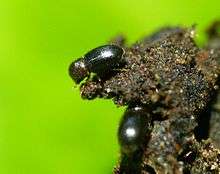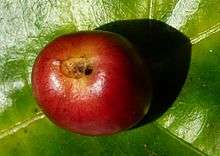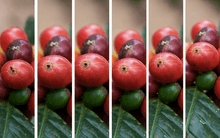Coffee borer beetle
| Coffee borer beetle | |
|---|---|
 | |
| adults on damaged bean | |
| Scientific classification | |
| Kingdom: | Animalia |
| Phylum: | Arthropoda |
| Class: | Insecta |
| Order: | Coleoptera |
| Family: | Curculionidae |
| Subfamily: | Scolytinae |
| Genus: | Hypothenemus |
| Species: | H. hampei |
| Binomial name | |
| Hypothenemus hampei (Ferrari, 1867) | |
| Synonyms | |
|
Cryphalus hampei Ferrari 1867 | |
The coffee berry borer, Hypothenemus hampei, is a small beetle native to Africa. It is among the most harmful pest to coffee crops across the world where coffee is cultivated.[1] Some Spanish common names of the insect include barrenador del café, gorgojo del café and broca del café.
Description
The larva is white, with a brown head and a length of 0.7–2.2 mm and a width of 0.2–0.6 mm. Females have two larvae stages and males only one. They have strong mandibles, and their larval phase lasts 10 to 26 days. The pupae are yellowish, with a length of 0.5–1.9 mm.
The adults are small black beetles. Females are 1.4–1.8 mm long. The males are smaller, 1.2–1.6 mm long. Female beetles can fly short distances; males have no wings. Females have four to six teeth in the frontal margin of the pronotum. H. hampei is confused sometimes with the false borer (H. obscurus or H. seriatus) and Xylosandrus (Scolytidae), but these species do not enter the coffee bean endosperm.
Life cycle
The maturation of the insect (from egg to adult) lasts between 24 and 45 days, varying according to the weather. Usually, the female drills the berry through the central disc, although it can enter through the side walls if the fruit is dry. Two days after the access, the beetle lays 35–50 eggs, which produce 13 females for each male. The lifespan for females is 35–190 days and for males 40 days. The new insects mate inside the seed. Some females lay the eggs in the same coffee plant, others colonise new ones. The males never leave the fruit.
The same plant can host three to five generations of beetles. Up to a hundred beetles can be found in a single fruit. The insect is very sensitive to desiccation, and waits for the rains to leave the fruit. The most affected areas in the crops are the shady and moist ones.
Parthenogenesis
In some cases, the reproduction of the insect can be parthenogenetic, so the female beetle can lay fertile eggs without mating. This characteristic and the asymmetry in the proportion of females to males is thought to be induced by the cytoplasmic bacterium Wolbachia.
Colonisation


The main host of H. hampei is Coffea arabica, but other coffee species have been affected in some cases. The female beetles attack the fruits from 8 weeks past the flowering to 32 weeks. When the insect enters, it builds galleries in the endosperm where the eggs are deposited.
Distribution
The distribution of the pest corresponds to the entire area of coffee crops. The accidental transport of contaminated seeds is believed to be the cause. The insect was native to Angola, and spread to the rest of Africa during the 1920s. The first reports of it in the American continent were in Brazil (1926).[2] In the 1970s it affected Guatemala and Mexico. The beetle entered Colombia during the late 1980s. It entered the Dominican Republic in the 1990s. It was detected in Puerto Rico in August 2007. It was discovered in Kona (Big Island), Hawaii in September 2010.[3]
Control
The presence of the insect affects the economy of over 20 million families that depend on the coffee harvest. It has caused marked reduction in the prices of coffee reducing the sale price to growers. The beetle can destroy the entire harvest of an area. The main measures against the pest are preventative. The application of efficient control programs is difficult, since the coffee plant is perennial, with several flowering periods, and grows in areas with very unpredictable weather.
Prevention
Prevention is based in the careful inspection of the coffee beans before leaving the coffee farms to avoid spreading of the insects. Also a number of border controls has been established in countries with coffee crops.
Natural resistance
Some Coffea species are naturally resistant to the coffee berry borer. C. kapakata seems to be the most resistant.
Chemical control
Insecticides are useful only before the female beetle penetrates the berry. There are reports of resistance to endosulfan in New Caledonia.
Biological control
During the time when beetle offspring emerge from each commercially ruined berry to disperse, they are vulnerable to predation. The yellow warbler, rufous-capped warbler and other insectivorous birds have been shown to reduce by 50 percent the number of coffee berry borer beetles in Costa Rica coffee plantations.
Parasitoids
The parasitoids used to control the borer beetle are Hymenoptera (wasps) native to Africa. Although they have a low impact in the beetle population, the use of biologic control allows the product to qualify as organic food.
- Bethylid parasitoids (Bethylidae): Cephalonomia stephanoderis Betrem and Prorops nasuta Waterston were introduced in some Latin American countries from Africa during the 1980s and 1990s with low success. In the late 1990s, the C. hyalinipennis native of North America was described as attacking the borer beetle in Chiapas, south of Mexico. This species preys on the eggs of H. hampei. Another useful betylid is Sclerodermus cadavericus Benoit, but its management is difficult, since it is an aggressive wasp and can cause severe dermatitis.
- Eulophyd parasitoids (Eulophidae): Phymastichus coffea was discovered in Togo in 1987. It attacks the adult beetle, and mass-rearing in Colombia has been successful. It has a capacity to stay in the coffee crops for a long time.
- Braconid parasitoids (Braconidae): Heterospilus coffeicola Schmiedeknecht was observed in Uganda, but its reproduction in laboratories has been unsuccessful.
Predators
Ants (Hymenoptera: Formicidae) are the main predators of H. hampei. However, the research of Centro Nacional de Investigaciones de Café (Cenicafé, Colombia) reported other insect families implicated in the predation: Anthocoridae (Hemiptera) and Cucujidae (Coleoptera). These are the genus and species that have been reported to attack the borer beetle:
- Formicidae: Solenopsis, Pheidole, Wasmannia, Paratrechina, Crematogaster, Brachymyrmex and Prenolepis
- Anthocoridae: Calliodes and Scoloposcelis
- Cucujidae: Cathartus quadricollis (Guérin-Méneville)
Diseases
- Nematodes
Metaparasitylenchus hypothenemi (Nematoda: Allantonematidae) has been reported in Mexico. A Panagrolaimus sp. has been reported in the field in India. In laboratory experiments, Heterorhabditis sp. and Steinernema feltiae have been shown to infect the insect.
- Fungi
Beauveria bassiana produces high mortality in the beetle. Other fungi that attack the insect are: Hirsutella eleutheratorum, Paecilomyces sp. (the insect pathogenic species in the genus Paecilomyces have been renamed as Isaria), and Metarhizium anisopliae.
References
Bibliography
- Barrera JF, Parra M El café en Chiapas y la investigación en Ecosur. Ecosur pp. 6 (formerly available as http://www.ecosur.mx/Difusi%F3n/ecofronteras/ecofrontera/ecofront12/cafe%20en%20chiapas.pdf)
- Borbón, O (1991) La broca del fruto del cafeto: programa cooperativo ICAFE-MAG. ICAFE. San José, Costa Rica. 50 pp
- Bustillo AE, Cardenas R, Posada FJ (2002) Natural Enemies and Competitors of Hypothenemus hampei (Ferrari) (Coleoptera: Scolytidae) in Colombia. Neotrop Entomol 31:635-639 available
- Camilo JE, Olivares FF, Jiménez HA (2003) Fenologíaión de la broca del café (Hypothenemus hampei Ferrari) durante el desarrollo del fruto. Agronomía Mesoamericana 14: 59-63 available
- Corbett, GH (1933) Some preliminary observations on the coffee berry beetle borer, Stephanoderes (Cryphalus) hampei Ferr. J Malayan Agric 21:8-22.
- Jaramillo J, Borgemeister C, Baker P (2006) Coffee berry borer Hypothenemus hampei (Coleoptera: Curculionidae): searching for sustainable control strategies. Bulletin of Entomological Research 96:223-233 (correo electrónico del author: dg@icipe.org)
- Rojas MG, Morales-Ramos JA, Harrington TC (1999) Association between Hypothenemus hampei (Coleoptera : Scolytidae) and Fusarium solani (Moniliales : Tuberculariaceae). Ann Entomol Soc Am 92:98-100 available
Notes
- ↑ Jaramillo J, Borgemeister C, Baker P (2006) Coffee berry borer Hypothenemus hampei (Coleoptera: Curculionidae): searching for sustainable control strategies. Bulletin of Entomological Research 96:223-233
- ↑ The entry to Java is dated about 1909 and Borneo in 1919.
- ↑ Tiny Pest Threatens Hawaii's Coffee Crop. 09 September 2010. Andrew Pereira (KHON2). http://www.khon2.com/news/local/story/Tiny-Pest-Threatens-Hawaiis-Coffee-Crop/ZrdpxV-zHU2-WMhvK0_z_A.cspx accessed 10 September 2010.